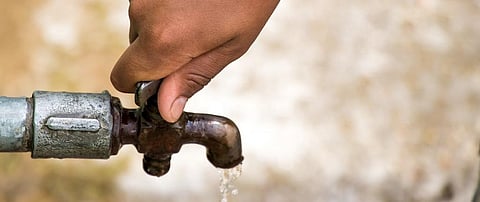Government must prioritise on conserving water
Water and life are connected to each other and we cannot separate one from the other. It constitutes for more than 80 per cent of an organism and is, therefore, the limiting factor for life. Water moves in a cycle: Mountain to river, river to ocean, ocean to rain, rain to mountain and so on. Water is a natural resource and is available in ocean, rivers, ponds, lakes, icecaps, wetlands etc.
The holding capacity of water depends on soil texture and rate of percolation. Some amount of water also gets locked beneath the Earth's surface, and its recharge depends on the availability of surface water, soil texture and land use among others.
The usage of water should primarily be based on the priority of its requirements; however, it has never been rational. As a result, 91 per cent of river water gets diverted for irrigation, leaving aside all other priority uses.
Had rivers been determined as the prime source of drinking water, the action plans would have been different. As drinking water was never a priority, we kept polluting them indiscriminately. Now, piped water supply has been provided to households, but without a formal training on the rational usage of water.
Excess use or discharge from all users is adding unnecessary load to our sewage treatment plants (STPs) and increasing the treatment cost. Untrained operators are also deterring the successful operation of STPs.
We need to understand that the holding capacity of any natural resources is limited and cannot be increased by any technology nor can it be added from any other planet. Moreover, the natural replenishment rate is also very slow and it cannot be increased by any technology. Thus, we can at the best plan for rational exploitation that is matching with our optimum requirement for use.
The wastewater generated in the form of sewage, effluent etc. are also considered as displaced resources. Therefore, it needs to be converted into water resources (by various treatment processes), so that they can be used as first-order resources to cut, reduce and prevent further exploitation.
Thus, the foremost task at hand for the new government is creation of a map showcasing availability of water from various resources like surface, pond, lake, reservoir, groundwater at each and every village.
They also need to educate people about extraction for various uses. The map should become the deciding factor for further development. Quantum of water availability should also be monitored on a regular basis and the map must be updated accordingly.
Our river systems are suffering badly from water scarcity and non-point source pollution. There is also uneven distribution of water for various uses including drinking. The new government should first decide on the rational distribution of irrigation water and diversion of excess water back into the river. But, the main focus should be on conserving water from agricultural use.
For extraction of water, an estimation of minimum flow requirement of all stretches and water availability at each stretch should become the deciding factor.
It is said 75 per cent of our water bodies are polluted. We have altered many lakes, ponds for urbanisation, industrialisation or change in land use pattern, etc and have also exploited our groundwater resources at a faster rate than anticipated.
All water bodies are connected and complimentary to each other. Flowing rivers are the recharging sources for lake, pond, well water, and even ground water. The natural flow of river purifies water and recharging further cleans it as it passes through the sand column of soil.
To maintain the natural flow of rivers, the need is to calculate the minimum water requirement of rivers —from stretch to stretch, terrain to terrain and gradient to gradient. The flow should be such that each river must fulfil the first criteria of self-cleansing capacity. Once it is maintained, the river bed would remain clean and scope of recharging capacity would definitely increase.
By not maintaining with minimum flow of rivers, siltation increases, water holding capacity decreases and the areas become vulnerable and prone to floods.
Therefore, planning for urbanisation or any growth should be decided based on the availability of water and its allocation should be determined based on the priority, including for agriculture. It should not be like the current practice of constructing a dam to divert the water, leaving the river to dry. Drying the river stretch disrupts continuity of river and leads to loss of biodiversity and the ecosystem. We need to remember that maintaining a strong ecology is key to a strong economy.
All treated water should be utilised for irrigation, fish culture, horticulture, gardening, water sprinkling and no fresh water should be permitted for these activities. The government should also introduce a basin concept for protection and conservation of water.
No treated or untreated water should be allowed to discharge into any river; there should be no indiscriminate withdrawal of water from any source except from water harvesting.
Other measures which the new government should immediately adopt include identification of non-point sources, restricting abstraction of water for the purpose of cultivating the river bed, total ban on sand mining, undertake dredging of river beds to increase water holding capacity, and monitor groundwater recharging at regular intervals.
Any natural resource management is meant for all; therefore all should be educated and taken on board.
(The author is former additional director at Central Pollution Control Board (CPCB).


